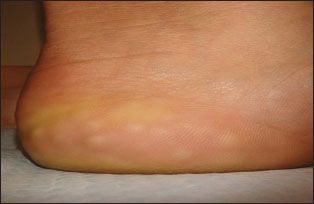- Clinical Technology
- Adult Immunization
- Hepatology
- Pediatric Immunization
- Screening
- Psychiatry
- Allergy
- Women's Health
- Cardiology
- Pediatrics
- Dermatology
- Endocrinology
- Pain Management
- Gastroenterology
- Infectious Disease
- Obesity Medicine
- Rheumatology
- Nephrology
- Neurology
- Pulmonology
Piezogenic Pedal Papules
These grouped, white to flesh-colored papules on the plantar aspect of a 28-year-old woman's heels appeared during weight bearing and disappeared in non–weight-bearing positions. The patient, a nurse whose work required standing for hours, noticed the lesions about a year earlier. Her medical history was unremarkable, and she was taking no medications. Her sister had similar lesions on her heels.

These grouped, white to flesh-colored papules on the plantar aspect of a 28-year-old woman's heels appeared during weight bearing and disappeared in non–weight-bearing positions. The patient, a nurse whose work required standing for hours, noticed the lesions about a year earlier. Her medical history was unremarkable, and she was taking no medications. Her sister had similar lesions on her heels.
Piezogenic pedal papules are common and benign; they result from fat herniation through the dermis. They occur in up to 80% of the population and are usually asymptomatic.1 Occasionally, the papules are painful. The pain has been associated with fat necrosis caused by a lack of blood supply from compression. Piezogenic papules also occur on the wrists and can be either asymptomatic or painful. Management is the same for both locations.
Piezogenic papules show no race predilection and can occur at any age, including infancy. They have been reported more frequently in women. Familial association has been reported, although most often it is unrelated.
The papules have been associated with Ehlers-Danlos syndrome.2 An increased incidence has been noted with obesity, excessive weight-bearing exercise, and flatfeet, although the condition is most often idiopathic. Conditions that may mimic piezogenic pedal papules include xanthomas, tophi, skeletal abnormalities, and infantile pedal papules.3
Usually a clinical diagnosis, piezogenic papules warrant further workup in patients with signs and symptoms of Ehlers-Danlos syndrome, such as hypermobile joints. Imaging may be necessary if orthopedic abnormalities are suspected.
No treatment is required for asymptomatic lesions. For painful papules, restriction of excessive weight-bearing activity, orthotics, surgical excision, and intralesional corticosteroid injections have been used.4
References:
REFERENCES:
1.
Zaidi Z, Jafri N, Noori B, Thawerani H. Piezogenic papules: a study of 100 cases.
J Pak Med Assoc
. 1995;45:93-94.
2.
Kahana M, Feinstein A, Tabachnic E, et al. Painful piezogenic pedal papules in patients with Ehlers-Danlos syndrome.
J Am Acad Dermatol
. 1987;17(2 pt 1):205-209.
3.
Greenberg S, Krafchik BR. Infantile pedal papules.
J Am Acad Dermatol
. 2005;53:333-334.
4.
Doukas DJ, Holmes J, Leonard JA. A nonsurgical approach to painful piezogenic pedal papules.
Cutis
. 2004;73:339-340, 346.
